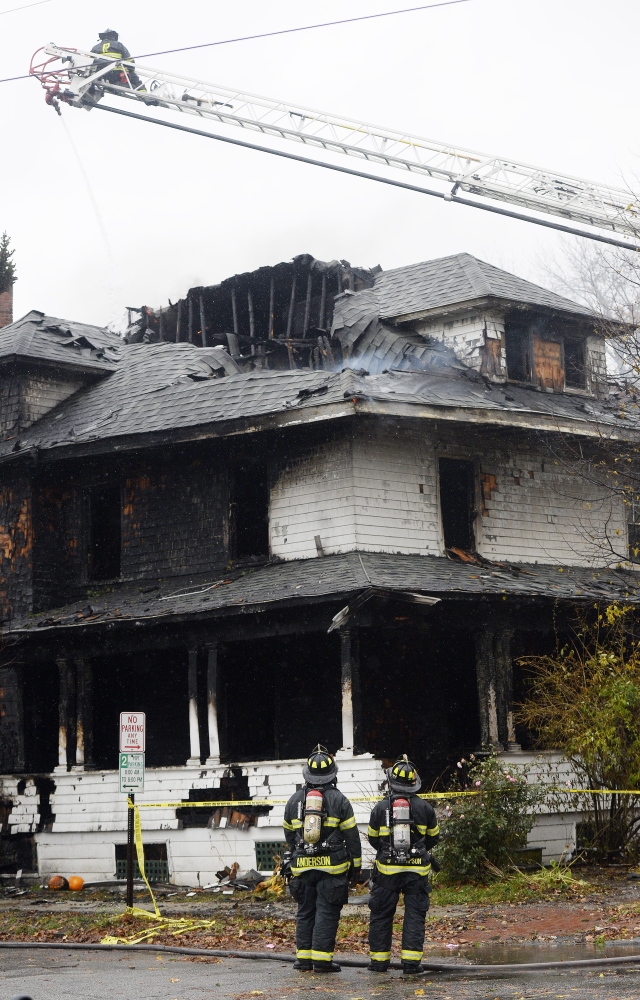A former Portland housing inspector testified Thursday that he never inspected the third floor after the city received a complaint in 2012 about an illegal third-floor apartment in a Noyes Street building owned by Gregory Nisbet.
A fire erupted in the building two years later, and two women and a man died in third-floor rooms that prosecutors have called “death traps” because the windows were not large enough to escape through. One survivor described hearing women screaming for help as he and others fled the intense smoke and heat by climbing out a second-floor window.
Testimony about the city’s oversight came as the defense presented its case in Nisbet’s trial on six manslaughter charges, one for each of the six people killed in the Nov. 1, 2014, fire, the state’s deadliest in 40 years.
The victims included tenants David Bragdon Jr., 27, Ashley Thomas, 26, and Nicole Finlay, 26. Steven Summers, 29, of Rockland, Maelisha Jackson, 23, of Topsham and Christopher Conlee, 25, of Portland were visiting the house and also died.
The trial began Monday in Cumberland County Superior Court, and closing arguments are expected Friday afternoon. It’s unclear whether Nisbet will testify in his own defense.
LIMITED INSPECTION OF BUILDING
On Thursday, defense attorneys continued to build their case that the duplex was being operated as a single-family unit rather than as a rooming house, as the state maintains. A fire expert for the defense also argued Thursday that the fire was much larger and spread more quickly than the state’s evidence indicates. The defense contends the fire could have spread quickly enough to disable any functioning smoke detectors before they would have been activated, and that most of the victims would have been too intoxicated to respond to any alarm.
But the biggest revelation came in the morning, when a former code officer for the city acknowledged that he never inspected the third floor after the city received a complaint about an illegal unit there.
Defense attorneys called two former city code enforcement officers, both of whom conducted limited inspections of 20 Noyes St.
Both inspectors testified that it was the city’s practice to inspect properties based on a specific complaint. While they primarily aimed to resolve any complaints, they also might have noted other code violations they observed. However, complaints did not lead to a full inspection of the property.
George Froehlich, who worked as a city code officer from 2011 to 2015, said he responded to the August 2012 complaint about an illegal apartment on the third floor. He said he talked with one or two tenants, who told him there was no new apartment on the third floor.
Froehlich said he did not inspect the third floor, but he did attempt to reach Nisbet to discuss the complaint. His handwritten notes indicate Nisbet did not call back. While there, Froehlich pointed out the buildup of trash on the porch to the tenants and it was addressed.
A review of city records for 20 Noyes St. reveals no building, electrical or plumbing permits that would be needed to convert the third-floor attic into two bedrooms and a bathroom. Had a permit application been filed, the issue of the window sizes might have come to light.
The city disclosed after the fire that it had received a complaint in 2012 about the third floor. However, city officials at the time refused to disclose what was done in response to that complaint, saying it was part of the investigation. It did not become public until Froehlich testified Thursday that he never went upstairs to inspect the third floor.
The Noyes Street fire led to a review and overhaul of the city’s inspections program. Portland now has a housing safety office that oversees compliance with codes and has begun to institute regular inspections, in addition to responding to complaints.
WORKLOAD AFFECTED INSPECTIONS
City Hall Communications Director Jessica Grondin would not comment on whether the city was negligent for not inspecting the third floor after receiving the 2012 complaint. She noted that the city has since beefed up its inspections department, but would not say whether an inspector would have gone to the third floor under the new regime.
“We have revamped our inspection system with the new Housing Safety Office, but I am not able to speculate on how it would be handled today as there are too many factors to consider,” Grondin said.
At the trial, defense attorney Sarah Churchill stressed that neither Froehlich nor Arthur Rowe, the other former code officer who testified Thursday, noted any violations for the third-floor windows being too small to be used as an emergency exit.
Assistant Attorney General John Alsop, however, noted that Portland’s code office had only two or three inspectors and they had to limit the scope of their inspections to resolving specific complaints because they were overburdened by the workload.
“That’s an understatement,” Froehlich said.
STATE’S EVIDENCE CONTRADICTED
An assistant state fire marshal testified Wednesday that the bottom of a window intended as an emergency exit cannot be more than 44 inches off the floor and must have 24 inches of space to crawl through when in the open position. When a window is more than 20 feet off the ground, it must open up to a platform where someone could await rescue.
However, both former code inspectors said existing buildings would not necessarily be required to meet modern codes. The duplex was built in the 1920s.
Both inspectors said that converting an attic into bedrooms and a bathroom would have required a permit and that those permits would trigger inspections. Froehlich said he was not aware of any such permits for 20 Noyes St.
Earlier Thursday, the manslaughter trial resumed and the defense moved that Nisbet be acquitted. Justice Thomas Warren denied the motion.
The defense also called its own fire expert to dispute the state’s findings about the fire’s intensity and the speed with which it moved through the apartment.
Craig Williams, who investigates fires for manufacturing companies, said the state’s fire model failed to take into account the amount of flammable materials on the front porch, as well as a strong wind blowing into the apartment. Taking those into account, the fire and heat would have traveled fast enough through the apartment – within 10 seconds – to disable any working smoke detectors before they could have sounded, he testified.
The intensity of the heat would have incapacitated the tenants within seconds, making it impossible for them to escape, he said.
Williams said the state model also assumed that all of the doors and windows were closed. If any had been open, the fire would have moved even faster.
That testimony contradicts evidence introduced by the state. It included testimony from two survivors who described their harrowing escape, which took longer than 10 seconds. Also, the state medical examiner testified that the cause of death for the five people inside the house was smoke inhalation and that all burns were received after they died.
Staff Writer Megan Doyle contributed to this report.
Send questions/comments to the editors.






Comments are no longer available on this story